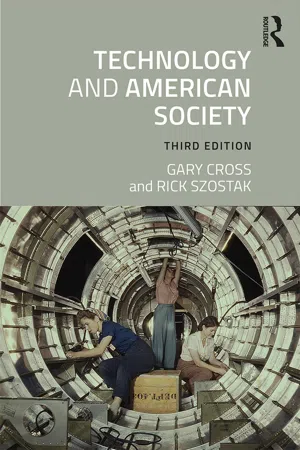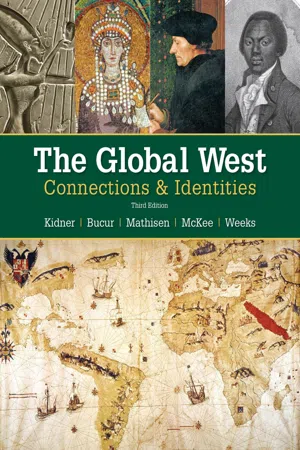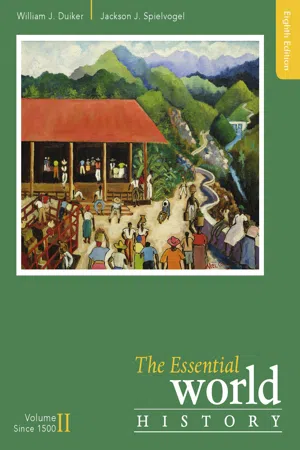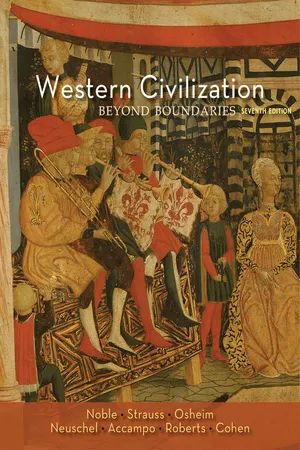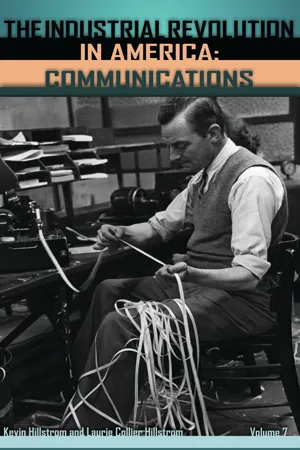History
Origins of Industrialization
The origins of industrialization refer to the period in history when societies transitioned from agrarian economies to industrial economies. This shift was marked by technological advancements, such as the development of machinery and the use of steam power, which transformed production processes. Industrialization led to urbanization, the rise of factories, and significant changes in social and economic structures.
Written by Perlego with AI-assistance
Related key terms
1 of 5
9 Key excerpts on "Origins of Industrialization"
- eBook - ePub
Technology and American Society
A History
- Gary Cross, Rick Szostak(Authors)
- 2018(Publication Date)
- Routledge(Publisher)
3 Origins of IndustrializationThe complex of events that began the shift from artisan and agrarian societies to economies dominated by manufacturing and machine-made goods is traditionally called the Industrial Revolution. It began in Britain, although these revolutionary changes would cross the Atlantic to take a particular American character within a generation. Much ink has been spilled over the question of whether we should speak of an ‘Industrial Revolution’ of the late eighteenth and early nineteenth centuries. The word ‘Industrial’ is too narrow, for the changes in this period affected not just the manufacturing sector but home and farm as well. Nevertheless, one of the key characteristics of the period was that half of the British population came to work outside agriculture. Britain’s industrial prowess would allow the importation of food from other countries in the late eighteenth century. Much later, in the late nineteenth century, mechanization and chemical fertilizers would emerge from the industrial sector to dramatically increase agricultural productivity. Although the agricultural sector had previously dominated the economy, from the time of the Industrial Revolution the industrial sector played that role.Some have disdained the use of the word ‘Revolution’ for a transformation that took more than a century. To be sure, it was only well into the nineteenth century that economic indicators such as per-capita income started to show any dramatic change. However, even political revolutions take many years to produce their full effect. We can hardly overestimate the impact on the world of this revolution. We have described in earlier chapters the static nature of the pre-Industrial Revolution world: Although innovations occurred and incomes rose, they did so at such a pace that people expected to die in a world that looked virtually the same as the one into which they were born. Per capita incomes would more than double in succeeding generations in Britain, North America, and elsewhere. - eBook - ePub
Industrialization as an Agent of Social Change
A Critical Analysis
- Herbert Blumer(Author)
- 2018(Publication Date)
- Routledge(Publisher)
2. Industrialization as a Process of Technological Development
A second view of industrialization places emphasis on the formation over time of the technical innovations and improvements that attend the development of manufacturing. This view is likely to be found chiefly among economic historians who have been concerned with tracing the emergence and growth of the industrial or manufacturing system. Noting the appearance of the industrial revolution and tracing meticulously its formation and subsequent development, their attention is focused on the string of technological developments that made possible our modern manufacturing system. Thus, they trace the series of inventions and technological improvements in machines, the series of developments in metallurgy that made possible the creation of machines and metal equipment, the series of technological achievements in the development of chemicals needed in manufacturing, the achievements in creating and utilizing new forms of physical power to drive machines, and the technical developments in the organization of industrial resources. Such lines of technological development are responsible for the historical formation of manufacturing as a type of economic production. Since manufacturing is the heart of an industrialized system, these technological developments are regarded, in turn, as constituting the vital or central part of industrialization. Thus, one detects amid the divergent thinking of scholars a strong disposition to identify industrialization with the technological developments responsible for the introduction and growth of the manufacturing nucleus.This conception of industrialization is very unsatisfactory in seeking to treat industrialization as an agent of social change. As in the case of the first view of industrialization that we have just considered, this conception of industrialization provides no lines of contact with group life. It gives no handles that can be grasped in trying to tie industrialization, as a process, into ongoing group life. To note, for example, the introduction of a new type of machinery in the manufacture of textiles provides no bridge to the detection or understanding of the social changes that this technological improvement is supposed to bring about. As I have had occasion to note in the previous chapter, technological changes of an industrial character are of primary significance in terms of their effect on the industrial system. Their subsequent, or secondary, effects on group life have to be traced through the impact of the changed manufacturing system on such group life. The conception of industrialization we are considering is obviously deficient in its failure to indicate the lines of such impact. - eBook - PDF
- Frank Kidner, Maria Bucur, Ralph Mathisen, Sally McKee(Authors)
- 2018(Publication Date)
- Cengage Learning EMEA(Publisher)
In other parts of Europe, industrialization came later but often developed even more quickly, pushed along by government investment and sub-sidies. Technology continued to develop rapidly, and new means of transportation—especially the railroad and steamships—shrank distance and time, encouraging intercontinen-tal trade and migration (see Map 21.1). The revolution in transport also opened the way for worldwide trade, even in fairly inexpensive products, and would help the European powers to 582 CHAPTER 21 Industrialization and Society, 1800–1850 also began to perceive themselves differently: as members of a new and potentially powerful working class. In both cases, this class consciousness meant that identity was derived not from birth but primarily from one’s position within the economy. Industrialization revolutionized production, efficiently mass-producing huge num-bers of items far more cheaply than could be done by hand. But the wealth produced by industrialization was uneven, and the gap between wealthy industrialists and their workers grew. Reformers fought against terrible working conditions, poverty, and exploitation of the workers by the capitalist system. Other reformers thought that justice for workers could be attained by government intervention, cooperation, and reforms. The Factory Acts in Britain in the 1830s seemed to remedy the worst conditions, and eventually workers’ pay also rose. But the socialist Karl Marx argued forcefully that only revolution would end exploitation of the working class and create a truly just and humane society. In many ways the world we know—running by the clock, fast paced, full of mass-pro-duced consumer goods, accepting constant change as normal—is a direct outcome of the Industrial Revolution, which began in the late eighteenth century and continued throughout the nineteenth century. - William J. Duiker, Jackson Spielvogel(Authors)
- 2016(Publication Date)
- Cengage Learning EMEA(Publisher)
The new industrial middle class was made up of the people who constructed the factories, purchased the machines, and figured out where the markets were 492 j CHAPTER 19 The Beginnings of Modernization: Industrialization and Nationalism in the Nineteenth Century Copyright 2017 Cengage Learning. All Rights Reserved. May not be copied, scanned, or duplicated, in whole or in part. Due to electronic rights, some third party content may be suppressed from the eBook and/or eChapter(s). Editorial review has deemed that any suppressed content does not materially affect the overall learning experience. Cengage Learning reserves the right to remove additional content at any time if subsequent rights restrictions require it. COMPARATIVE ESSAY The Industrial Revolution SCIENCE & TECHNOLOGY Why some societies were able to embark on the road to industrialization during the nineteenth century and others were not has long been debated. Some historians have pointed to the cultural characteristics of individ-ual societies, such as the Protestant work ethic in parts of Europe or the tradition of social discipline and class hierarchy in Japan. Others have placed more emphasis on practical reasons. To the historian Peter Stearns, for example, the availability of capital, natural resour-ces, a network of trade relations, and navigable rivers all helped stimulate industrial growth in nineteenth-century Britain. By contrast, the lack of urban markets for agricultural goods (which reduced land-owners’ incentives to introduce mechanized farming) is sometimes cited as a reason for China’s failure to set out on its own path to-ward industrialization. To some observers, the ability of western European countries to exploit the resources of their colonies in Asia, Africa, and Latin America was crucial to their industrial success.- eBook - PDF
Western Civilization
Beyond Boundaries
- Thomas F. X. Noble, Barry Strauss, Duane Osheim, Kristen Neuschel(Authors)
- 2013(Publication Date)
- Cengage Learning EMEA(Publisher)
Section Summary 598 Chapter 20 The Industrial Transformation of Europe, 1750–1850 Copyright 2012 Cengage Learning. All Rights Reserved. May not be copied, scanned, or duplicated, in whole or in part. Due to electronic rights, some third party content may be suppressed from the eBook and/or eChapter(s). Editorial review has deemed that any suppressed content does not materially affect the overall learning experience. Cengage Learning reserves the right to remove additional content at any time if subsequent rights restrictions require it. Key Terms 599 Chapter Summary ◆ ◆ What factors allowed Europe to industrialize before the rest of the world? Industrial transformation, which started around 1750 in parts of England, spread by 1850 to the Continent. The proximity of coal and iron, the relative ease of domestic transportation, a cul- ture open to innovation and entrepreneurship, and the existence of an already relatively dynamic economy help explain why Britain was the first nation to industrialize, and why industrialization spread—at varying paces—to much of Europe. The new industrial economy changed power rela- tions among European states and altered the relationship of Europe to the rest of the world. ◆ ◆ Which inventions appear to have been the most important in launching industrialization? A number of key inventions gave impetus to industrialization: John Kay’s flying shuttle increased the production of weaving; James Hargreave’s spinning jenny and Samuel Crompton’s mule more than met the increased need for thread production; and power looms soon followed. The use of coal to process iron made possible the creation of iron machinery that could be powered by James Watt’s steam engine, as well as stronger blast furnaces that could, in turn, improve iron processing. - eBook - PDF
- William Duiker, Jackson Spielvogel(Authors)
- 2018(Publication Date)
- Cengage Learning EMEA(Publisher)
Others have placed more emphasis on practical reasons. To historian Peter Stearns, for example, the availability of capital, natural resources, a network of trade relations, and navigable rivers all helped stimulate industrial growth in nineteenth-century Britain. By contrast, the lack of an urban market for agricultural products (which reduced landowners’ incentives to introduce mechanized farming) is sometimes cited as a reason for China’s failure to set out on its own path toward industrialization. To some observers, the ability of western European countries to exploit the wealth and resources of their colonies in Asia, Africa, and Latin America was crucial to their industrial success. In this view, the Age of Exploration led to the creation of a new “world system” characterized by the emergence of global trade networks, propelled by the rising force of European capitalism in pursuit of precious metals, markets, and cheap raw materials. These views are not mutually exclusive. In The Great Divergence: China, Europe, and the Making of the Modern World Economy, Kenneth Pomeranz has argued that access to coal resources and to the cheap raw materials of the Americas were both assets for Great Britain as it became the first to enter the industrial age. Clearly, there is no single answer to this controversy. In any event, the advent of the industrial age had a number of lasting consequences for the world at large. On the one hand, the material wealth of the nations that successfully passed through the process increased significantly. In many cases, the creation of advanced industrial societies strengthened democratic institutions and led to a higher standard of living for the majority of the population. It also helped reduce class barriers and bring about the emancipation of women from many of the legal and social restrictions that had characterized the previous era. On the other hand, not all the consequences of the Industrial Revolution were beneficial. - eBook - PDF
The Abolition of Slavery in Brazil
The Liberation of Africans Through the Emancipation of Capital
- David Baronov(Author)
- 2000(Publication Date)
- Praeger(Publisher)
Among the first global arenas to be the subject of such an analysis was Central and Eastern Europe during the transition from serf-labor to "free" labor at the end of the 19th century. The works of The Origins of the Modem Industrial Working Class (1817-1870) 75 Kautsky and Lenin set the terms for much of the 20th-century interpretation of Marx on this point of development and for the study of the transition from "precapitalist" agrarian societies to capitalist industrial societies in general. For this reason, the next chapter begins with a tour of Central and Eastern Europe in the throes of 1848, its dismantling of serfdom and the early 20th-century "agrarian question" literature growing out of this historical epoch. NOTES 1. The occupational distribution of labor for select countries for the years 1825- 1891 reveals this well. Britain for the years 1801, 1841 and 1891 had its percentage of workers in agriculture drop from 32%, to 22%, to 6%, respectively. At the same time, its percentage of workers in industry grew from 23%, to 34%, to 40%, respectively. Its percentage of workers in the service sector grew from 45%, to 44%, to 54%. French agricultural workers represented 50%, 42% and 35% for the years 1825, 1872 and 1908. Industrial workers for the same years represented 25%, 30% and 37%. Service workers represented 25%, 28% and 28%. In 1860, 32% of German workers were in agriculture, 24% in industry and 44% in services. By 1905 those in agriculture represented 18%, in industry 39% and in services 43% (Minchinton, 1973a, p. 156). 2. In 1800 there were 23 towns with populations of 100,000 or more. By 1850 there were 47 such towns. London alone grew from 960,000 to 2 million. Paris grew from 550,000 to 1 million (Droz, 1967, p. 21). 3. The limited emigration of British artisans until 1825 and a ban on the export of major textile inventions and machinery from Britain until 1842 helped safeguard Britain's advantage. - eBook - PDF
The Industrial Revolution in America
Communications, Agriculture and Meatpacking, Overview/Comparison [3 volumes]
- Kevin Hillstrom, Laurie Collier Hillstrom, Kevin Hillstrom, Laurie Collier Hillstrom(Authors)
- 2007(Publication Date)
- ABC-CLIO(Publisher)
At the same time, auto manufacturing also suggests some of the problems that arose from the Industrial Revolution itself. Work in assembly line factories was often repetitive and tedious, which frequently led both to dissatisfied workers and to dangerous errors in production. In addition, the sky- rocketing demand for autos tempted industry leaders to increase pro- duction (and profits) with little consideration of how workers or the environment might be affected. The New Economics of Adam Smith Along with the industrial and technological innovations that created the Industrial Revolution, it is important to understand the ideologi- cal innovations that guided the actions of both government and in- dustry. Some of these have already been mentioned, such as the En- closure Movement, which started the trend away from communal 56 • Overview/Comparison Innovations and Inventions • 57 farming and grazing and led to the privatization of land use. The transition from a farming society, in which families created their own products within the home, was sparked by innovative thinkers such as Matthew Boulton, James Watt’s partner in steam engine manufac- turing, who promoted the idea of gathering workers in manufacto- ries. Samuel Slater, the industrialist who smuggled British machine designs into the United States, expanded on Boulton’s idea by creat- ing the factory town, where workers lived, shopped, and even at- tended church and school. Eli Whitney, Ransom Olds, and Henry Ford streamlined factory production, creating a workplace where the worker became almost part of the machinery. Another important influence on Industrial Revolution philosophy was Adam Smith (1723–1790). Born in Kircady in Scotland, Smith became the first political economist, introducing innovative ideas about money and industry that still shape modern economies. Smith’s father died shortly before his birth, and he was raised by his mother. - eBook - PDF
The Constitution of the City
Economy, Society, and Urbanization in the Capitalist Era
- Allen J. Scott(Author)
- 2017(Publication Date)
- Palgrave Macmillan(Publisher)
39 © The Author(s) 2017 A.J. Scott, The Constitution of the City, DOI 10.1007/978-3-319-61228-7_3 CHAPTER 3 Industrialization and Urbanization in Early Capitalism PRELIMINARY OBSERVATIONS Cities have been present in human society for the better part of nine or ten millennia. Over most of this period, cities were for the most part small, and, compared with today’s world, few in number. 1 Until relatively recent times, individual cities rarely attained populations of more than a few thousand, though in some instances much larger sizes have been recorded, especially in cases where cities functioned as imperial capitals. 2 The popu- lation of Ancient Rome is said to have been over one million, and Hangzhou and Constantinople in the medieval period are estimated to have had close to the same number. However, it is only with the great growth of trade and industry after the seventeenth and eighteenth centu- ries that urbanization made its way into human society on a massively pervasive and ever-increasing scale. The origins of this trend coincide with the rise of mercantilism and the increasing integration of major cities in Western Europe and North America into trans-Atlantic networks of trade including the notorious triangular trading system involving the shipment of manufactured goods, slaves, and sugar in a circuit encompassing Europe, West Africa, and the Caribbean and in a corresponding circuit based on the Northeastern United States. Mercantilism stimulated the growth of major seaports and commercial centers in Europe and North America and helped to estab- lish the economic groundwork of the Industrial Revolution. As such, it 40 also foreshadowed the emergence of capitalist society and its colonial extensions, which in turn further promoted urban growth in Europe and North America together with a special kind of urbanization based on entrepôt activities in various dependent territories.
Index pages curate the most relevant extracts from our library of academic textbooks. They’ve been created using an in-house natural language model (NLM), each adding context and meaning to key research topics.
